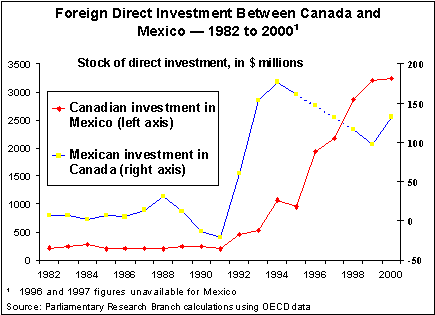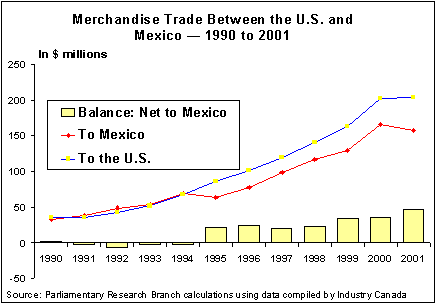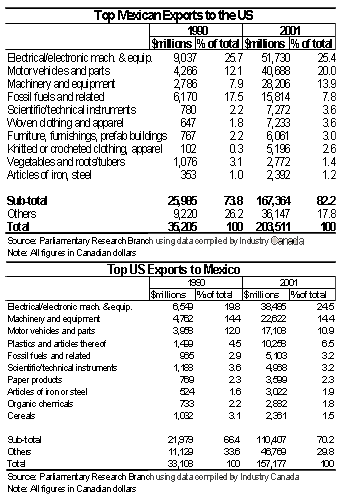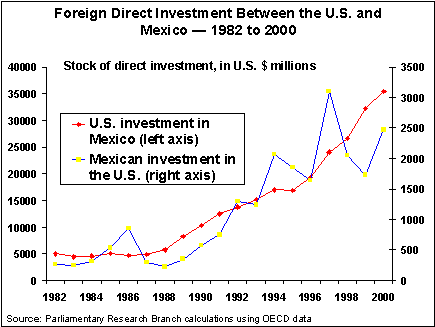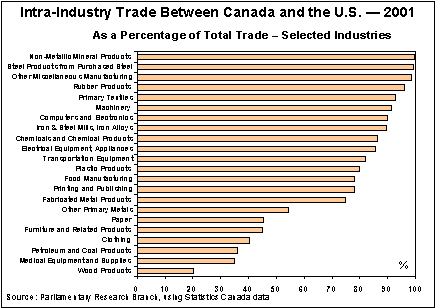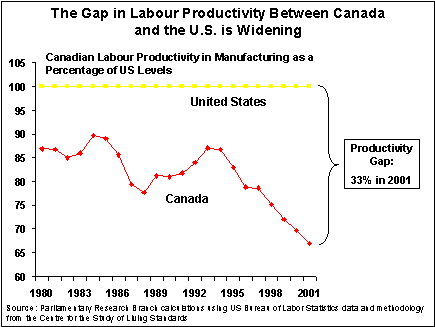FAIT Committee Report
If you have any questions or comments regarding the accessibility of this publication, please contact us at accessible@parl.gc.ca.
|
CHAPTER 2: UNDERSTANDING A There will always be issues that the United States, Canada, and Mexico would rather not hold in common, but even then North America will remain a reluctant trinity, always together, though not always in agreement. Our futures are overlapping whether we like it or not. Anthony DePalma, Geography makes Canada a North American nation — combined, especially in the case of the United States, with historic friendship, alliances and partnership, as President John Kennedy famously underlined in an address to the Canadian Parliament in 1961.1 As the Committee has argued in Chapter 1, however, there is nothing necessarily “manifest” (in the sense of destiny preordained, or options foreclosed) about the trajectory of Canada’s relationship with its powerful neighbour, or about the future shape of a post-NAFTA North American region that includes more integrated relationships with Mexico as well. Indeed we share a continent, but how we share it is still a matter for Canada and Canadians to decide. Canada’s place within North America has been debated for as long as there has been a Canada.2 Yet entering a new century may mark a new and much more complex phase in what has been a long, uncertain, even “ambivalent” evolution. Whither, then, a changing Canada within a changing North America? Do we have a sense of the Canada we want in terms of the North America we want? Or have we only just begun to ask that kind of question, despite the enormous economic linkages with our NAFTA partners that dwarf all of our other trade and investment relationships combined? The American journalist “biographer” of North America Anthony DePalma laments: “We know North America exists, but we do not know North America.” Yet he goes on to suggest: “The drug trade, international trade, immigration, cultural exchange, mass communications, shared defense — all are linkages across our borders that are leading inevitably toward the integration of North America into a single, seamless entity.”3 This leap of logic was written before September 11, 2001; no doubt the common imperatives of protecting North Americans from terrorism would now be added to that list. Most Canadians, however, would doubtless contend that the pursuit of closer relations among North American partners, based on certain concrete mutual interests, is very different from the highly institutionalized path of complicated political as well as economic integration on which European Union members states are presently embarked. For most Canadians, the prospect of a similar North American union emerging is unlikely, even in the longer term.4 In a highly varied continental landscape, marked by obvious asymmetries among the partners, the destination of relations remains uncertain. As acknowledged in a recent government-supported research report on future scenarios for North American integration, and as testimony before the Committee confirmed, counter-integration scenarios can also be envisaged that might seek instead to affirm a broader multilateralism, to distance Canada from North American partnerships, or to derail deeper integration options. The more likely prospects, however, would seem to be for a continuation of the mainly bilateralist status quo, perhaps in an enhanced form, or for some further institutionalization — albeit probably quite limited — of North American relations along trilateral lines.5 The Committee will address in Chapter 5 some of the more speculative of these options, including calls for building a trilateralist “North American community” — notably the case put forward to us by academic policy advocates like Dr. Robert Pastor6 as well as the “North American vision” embraced by leading members of the Fox administration and others in Mexico. What we want to concentrate on at this stage is getting a clearer grasp of some of the main features of the North American empirical landscape. We also refer to recent surveys of public attitudes in the three countries that will continue to condition the environment for Canadian policy responses, whether or not any of those futuristic integration ideas are eventually taken up.
As indicated by the regional socio-economic profile in Box 1, and as thoroughly reviewed in this chapter’s Section B overview of an emerging North American economic space, the facts of intensified economic linkages among Canada, the United States, and Mexico are hard to escape. Indeed, by the end of the 1990s, eight of ten Canadian provinces were trading more internationally than interprovincially,7 and the volume of Canada’s NAFTA trade is now double that of interprovincial trade. Mexico has become even more trade-dependent on the U.S. market than has Canada, and in an even more asymmetrical way. During the past decade these growing linkages have also been accompanied by government policy agendas that, with certain protectionist exceptions, have broadly supported a liberalization of flows of goods, services, investment and capital, if not labour, across the continental economy. The wider impacts of these North American economic trends have been variable, as well as difficult to disaggregate — for example, from more general factors such as government cutbacks to eliminate budget deficits, technological change or other “globalization” forces. In estimating net gains or losses, William Kerr of the Estey Centre for Law and Economics in International Trade also pointed to “the very long adjustment process that takes place when you put in a major trade liberalization like the NAFTA.”8 Supporters as well as critics of the trade agreements have found fault with Canadian socio-economic performance since their entry into force. For example, Jayson Myers told the Committee that Canada “has become a relatively poorer market over the past ten years as a result of declining per capita incomes and a depreciating dollar…. Canada runs the risk of becoming a marginalized economy within North America.”9 For their part, labour spokespersons and civil society critics of the free trade agreements often contended that there has been little evidence of promised productivity or real wage gains. At the same time, Professor Teresa Cyrus referred to research indicating that trade exposure seems to have played little part in rising poverty levels or income inequalities.10 Solid data are often hard to come by or contested as to interpretation, even in regard to NAFTA’s economic effects. It is unsurprising, then, that a forthcoming critical review of NAFTA by a Canadian analyst finds its broader social impacts to be difficult to evaluate and cautions that official promotional claims should be balanced against more troubling observations.11 There is a continuing need to deepen understanding of the full impacts of North American integration, taking into account a range of related public concerns in all three countries. As shown by the data in Box 1, all three countries of North America have recorded a progressive rise in “human development” performance indicators during the period of freer trade. Relative disparities remain a major policy challenge, however, with Mexico as a whole still far behind Canadian and American living standards. Research presented to the Committee by Dr. Mario Polèse also showed some parts of North America to be better positioned to benefit from liberalized continental economic linkages than others. For example, within Canada, Ontario has increased its economically dominant position; within Mexico there is a sharp north-south divide.12 Obviously, persistent regional and social disparities are a challenge to governments in terms of developing policies that can respond adequately to both the combined and the uneven impacts of these economic changes across North America. That is also a shared trilateral challenge about which we will have more to say in Chapter 5. To date, however, there has been little policy deliberation in common among the three countries in that regard. There is even less sense of a shared North American “projet de societé”, despite debate during the NAFTA negotiations about adding a NAFTA “social dimension” and current Mexican President Vicente Fox’s championing of a broader development “vision” for North America. Even between Canada and the United States, high and growing levels of economic interdependence do not seem to have led to as much policy convergence as might have been expected, desired, or feared.13 With respect to public attitudes and feelings about national identities, a similarly complicated and often ambiguous picture emerges across North America from the plethora of polls probing Canadian, American, and to a lesser extent, Mexican opinions, in particular since September 11, 2001. Sometimes these serial snapshots of the public mood do more to confuse than to clarify. Nonetheless, among the most consistent findings are that majorities in the three countries have become more comfortable with the idea of closer economic relations (if remaining ambivalent about who benefits from agreements like NAFTA); yet at the same time, most citizens also remain attached to maintaining differences in national public values and separate political identities. This kind of national consciousness certainly appears to characterize general Canadian public opinion and indeed may have become more pronounced, even while private-sector elites have increasingly tended to favour continental integration.14 An updated analysis from the World Values Survey comparing 2002 with 1990 data shows that Canadian respondents’ support for closer economic ties with the United States had increased (to 79% from 71%), as had support for “doing away with the border” (to 35% from 24%). However, the evidence also showed a positive association between support for closer Canada-U.S. economic ties and “higher levels of Canadian national pride.” That finding leads Neil Nevitte to conclude that this, along with a variety of distinctive value differences and concerns about culture, makes political integration an unwelcome prospect to most Canadians. At the very least, therefore, we should be careful about jumping to assumptions about that prospect being a sort of “slippery slope” following inexorably from the “spillover” effects of ever deeper economic integration.15 Findings from a major ongoing public opinion research project being carried out in the three countries by EKOS Research Associates, as released to a June 2002 conference on North American integration, suggest patterns of divergence as well as convergence (which should perhaps not be surprising, viewed in historical perspective).16 Consider, for example, the following conclusions from this unique trinational survey as presented by EKOS President Frank Graves:17
Several more recent surveys of Canadian public opinion on continental relationships have been conducted for the Canadian Centre for Research and Information on Canada (CRIC) in connection with a series of “BorderLines” conferences focusing on the future of Canada-United States relations.18 These polls show that many Canadians want to see Canada taking an independent approach in both domestic and international affairs and are opposed to an “Americanization” of Canada’s policies. As CRIC Assistant Director for Research Andrew Parkin has stated: Analysis of this particular data shows that Canadians feel that they have values and public policies that are distinct from those of the US and that this distinctiveness is worth preserving…. However, this is not an expression of anti-Americanism. The polls also show that Canadians favour close cooperation with the US in economic matters and North American security. What it means, quite simply, is that Canadians value their distinctiveness and wish to preserve their independence.19 With respect to Canada-U.S. economic cooperation, CRIC’s most recent survey, conducted by the polling firms CROP and Environics Research Group in September-October 2002, shows that 63% of Canadian respondents support free cross-border movement of labour, and 53% think having a common currency with the United States would be a good idea, though a majority would oppose Canada adopting the U.S. dollar. Overall, Canadians’ evident support for growing economic ties needs to be seen in a context of continuing sovereignty concerns and strong attachment to distinctive Canadian public values. As Andrew Parkin has summarized these findings: Canadians favour economic cooperation with the US, even to the point of supporting a cross-border job market or a common currency, both of which are already in place in the European Economic Union. But they do not want to adopt the US dollar, nor do they want to harmonize banking or tax policy. And, clearly, they draw the line at bulk water exports, because they see the country’s fresh water reserves as a cherished possession that is not for sale. Canadians want to pursue economic cooperation with the US without throwing away the country’s independence or compromise its most unique features.20 Other recent polling data from the Centre for Research and Information on Canada suggest that the effect of September 11 on Canadian attitudes had waned a year later. While only 13% of Canadians surveyed wanted more distant ties with the United States immediately following the terrorist attacks, that number was back up to 35% in September 2002, and only 28% wanted closer ties. Majorities ranging from a low of 60% in Ontario to a high of 80% in Saskatchewan also saw the United States as benefiting more from bilateral trade, no doubt reflecting frustration over current irritants. As well, nearly three-quarters saw Canada as offering a better quality of life than the United States, with that view most strongly held by young Canadians.21 In short, what the next steps should be in North American partnership are far from obvious, much less automatic or “inevitable”, on the basis of such varying and at times conflicting trends. In the Committee’s view, this should be seen less as a problem than as an opportunity to shape the future in accord with Canadian public values and interests. This is an opportunity for policy development to catch up to the dynamic factors of growing cross-border linkages in a challenging context that international relations scholars and students of Canada-U.S. relations have described as one of asymmetrical “complex interdependence.”22 It is also an opportunity that reinforces the argument we made in Chapter 1 about options remaining open for Canada in making the political choices that will surely be necessary to respond to a changing North America. Witness Perceptions of North America’s Future In an early panel, George Haynal, former Assistant Deputy Minister (Americas) in the Department of Foreign Affairs and International Trade, answered his own question “But what is North America?” as follows: North America at this stage is three countries of great diversity: the world’s dominant power; a middle-level industrial democracy in the front ranks of the modern world; and a large, dynamic, emerging, developing country. Between them, these three countries have four relationships, some much better developed than others. The two that are organic and have historic roots and enormous power are those between Canada and the United States and between the United States and Mexico. The other, between Canada and Mexico,… is now being built, and being built in unusually imaginative ways. The last … is the trilateral relationship, one that would build in North America a form of community.23 That statement neatly sums up the past and current situation of triple-bilateral/trilateral North American relations as prologue to future possibilities for the North American relationship as a whole. The Committee will examine the promise of Canada-Mexico and trilateral relations in detail in Chapter 5. But what we want to note here is that the extent of that promise largely depends, in the first place, on how much effort Canadians are willing to devote to pursuing the full potential of these multi-level North American relationships. Not surprisingly, some critics and sceptics of North American integration had little patience with this discussion. Rod Hill declared: “I see no reason that we should start thinking of ourselves as North Americans.… That’s an integrationist mindset.… Where has Pearsonian internationalism gone?” He added for good measure: “I see nothing special about Mexico just because it happens to be on the same geographic continent. I think we should think of ourselves as citizens of the world rather than promoting the idea that we’re North Americans in some sense, because we’re not.”24 David Orchard drew on historical grievances to argue for an aggressive rejection of closer Canada-U.S. ties. Anything else would be “giving up”, he contended.25 Others were more open to prospects for North American partnership but attached strong caveats to the ends and means of its construction. Stephen Clarkson agreed that, “There is no question that North American integration — and therefore Canada’s place in the new continental architecture — is the policy issue of the moment.” However, he concluded: “We need to recognize that the only legitimate goal of government is to enhance, not diminish, the quality of life for Canadians — and in terms defined by us, not by Uncle Sam.”26 Laura Macdonald saw arrangements that remain rather ill-defined, uneasy, and incomplete, suggesting we need to ask not only what North America is, but “what kind of North America?” As she explained: North American is a region that has sprung up without much thought having been put into its future outlines, its architecture, if you will.… Prior to September 11 there was concern in Canada about the apparent decline of Canada’s relevance in Washington, as a result of the rise in power of the U.S. Southwest, Latino voters, and the growing prominence of Mexico in the United States foreign policy world view. What we seemed to be seeing was the decline of the special relationship and the creation of the uneasy North American partnership. I say uneasy because of the apparent jealousy of the two subordinate partners, Canada and Mexico, as rivals for U.S. attention and affections. As we know, both Canada and Mexico entered into free trade agreements with the United States in order to gain special access to the U.S. economy, and they weren’t eager to share those benefits with each other.27 While Professor Macdonald saw NAFTA as finally putting Canada-Mexico relations into the mix, she argued that earlier stages in the process of North American integration were characterized by inadequate representation of a broad range of social sectors, resulting in counterproductive hostility and confrontation between government, business, and civil society. So I believe any further step towards integration needs to be accompanied by a constructive process of dialogue, such as, indeed, this committee has begun, and may even require re-examination of some aspects of the NAFTA, like Chapter 11, a real sore point with most elements of civil society. As well, Canada should support the development of ties between members of diverse sectors of civil society, like women and indigenous peoples, in the three countries.28 Among proponents of stronger North American ties, some envisaged this primarily if not exclusively in Canadian-American terms. Reginald Stuart, for example, cited the sharing of a legal heritage and “broadly common culture” that has developed into “alternate versions of a North American culture.” He also saw the Canadian-American relationship in terms of “dispersed relations”, characterized “not only as state-to-state relations but as provinces to states, … as regional linkages, and also as the linkages of peoples and cultures and values and societies.”29 With regard to the negotiation of North American agreements, Michael Hart argued that Canada should direct its major attention and efforts to the U.S. relationship and leave potential trilateral approaches to later. As he put it: I think the Mexican factor should not deter us from moving ahead. The United States has a different attitude toward Mexico. The Mexican response to the issues raised by September 11 has been different. Despite the fact that we have a common North American agreement, many issues between Canada and the United States are not shared by Mexico, and many issues between Mexico and the United States are not shared by Canada. At this particular time, it is critical that the two governments that share North America with the United States move ahead in parallel efforts, rather than in joint efforts. At some point in the future, they should determine the extent to which they have shared interests that can be brought into a single effort.30 The Committee will revisit these issues in Chapter 5, but we note that this suggestion of a sort of double bilateralism, or “North America at two speeds” as Christopher Sands described it in testimony last fall,31 conforms to our sense of how official Washington still operates in separate dealings with North American partners. There is an awareness in some quarters of issues that are becoming more North American in scope, and of cooperative arrangements or institutions that may be needed to manage these issues. But judging from our encounters in the U.S. capital, there is as yet little active American policy consideration, much less practice, being put into anything like the ambitious trilateral North American directions urged by former senior Carter administration official Robert Pastor, among others. This official American disinterest was in marked contrast to the messages conveyed to the Committee repeatedly by Mexican interlocutors at all levels, including members of the Mexican Congress and its Senate North American Committee. Mexicans acknowledged that North American lacks a “constituency”; perhaps also a clear shape and common purpose. Professor Guadalupe González of the Centro de Investigación y Docencia Económicas observed that for this “region in the making”, marked by diverse social views and dual anxieties over vulnerabilities to U.S. power, “there is no single understanding of the future of North America … [or of] which type or model of integration is feasible and desirable.”32 However, Mexican witnesses were unanimous in urging a stronger relationship with Canada and in linking that to a more fruitful trilateral approach. A farsighted, inclusive view of North America was also urged at various points during the Committee’s Canadian hearings. Dr. Brian Stevenson of the University of Alberta concluded that: “Although we benefit tremendously from our good bilateral relationship with the U.S., we are also terribly vulnerable because of it. Our next step should be to transform the three bilateral relationships into a North American community. This is in our national interest.”33 Stacey Wilson-Forsberg and Donald MacKay of the Canadian Foundation for the Americas (FOCAL) pointed out that “while there are a number of individuals and institutions well experienced in many of the issues at the centre of the discussion on North America, the evident weakness within Canada remains lack of knowledge about Mexico. It is perhaps also because of this knowledge gap that it has been so difficult to factor Mexico into our discussions about North America. For this reason, a two-speed model of integration is gaining strength in Canada, and we believe this model could be particularly worrisome.”34 Professor Stephen Blank of New York’s Pace University also recalled to the Committee that a great deal of “bottom-up” economic integration was already taking place prior to the free trade agreements, which he saw as a response to “changes in the economic environment that had already taken place.” The more NAFTA succeeds and economic linkages intensify within what is a de facto “North American economic community,” the greater the contradiction with a “very minimal governance system” at the North American level. As he put the challenge: “The great North American project that lies ahead, in which Canada’s interests can and should be maximized, is to build a constituency that supports the emergence of a North American community.” He saw this not as some homogenizing grand design, but as a multi-level, participatory, and interest-based public and private endeavour — I don’t think we see a North American identity in the future. … But I do think what we should be aiming at is a vision that recognizes the interests we share as North Americans in a freer, continent-wide economic system, in an effective and cost-efficient infrastructure that supports this system, and on a commitment to bring all citizens into the system to ensure that everyone benefits from participation in this North American community. We share interests. I don’t think identity is the issue.35 Guy Stanley of the University of Ottawa agreed that we are being challenged “to develop a made-in-Canada North American strategy, un projet de société nord-américain, plus précisement. Canada is uniquely suited to do this, but we haven’t done it, and the initiative has been taken by Mexico.” He added: “Some people may be a little hesitant to go forward in this direction, fearing standardization — the adoption of norms that are uncomfortable to ourselves. But on the contrary, having a clear North American management framework would provide protection for diversity, and allow diversity to flourish more strongly than at present.”36 Better Positioning Canada to Respond The critics of North American integration are unlikely to be persuaded of the merits of considering any deeper or broader integration options. But even most of them would surely agree that Canadian policymakers should have access to the best possible knowledge base so that they can be in the strongest position to assess major trends and respond to multiple developments within North America that affect Canadian interests and values. A principal message of this chapter is that complacency on that score will weaken Canada’s capacity to choose, whatever the objectives are that Canadians want their governments to pursue in a rapidly evolving North American context. Although that context may be dominated by a powerful United States, it is a very heterogeneous one, and it also includes a dynamic, fast-changing Mexico with already more than three times the population of Canada. Work is underway to improve the Canadian knowledge base; for example, through the federal-government-supported Policy Research Initiative (PRI) and its North American Linkages (NAL) Project. Much of this has focused on the implications for the Canadian public policy environment of an increasingly integrated North American economic space.37 And as Janine Ferretti, then executive director of NAFTA’s North American Commission for Environmental Cooperation told the Committee in Montreal: “I think all three countries need information to better understand what North America is, what the North American priorities are, what the trends are, what the challenges are.”38 In that regard, Stephen Blank also made the following telling comment: … as an educator, let me underline that many leaders in our governments, media, and academic communities know little about the developments in North America, despite the growing importance of these developments in our lives. Almost no resources are directed toward public information and education. There are almost no university institutes on North America, no programs of visiting faculty or student exchanges, no funds for collaborative research. There is no foundation or centre devoted to North American research. The gap between what is happening in our North American economy and what we know about it is enormous, and I see this as one of the most profound weaknesses in our North American system.39 Of course, North America’s future is about more than just economic integration, NAFTA impacts, or next steps. Fundamentally, it should be about what is best for the more than 400 million citizens of the three sovereign countries sharing that nearly $12 trillion economic space. To ascertain that means engaging a variety of stakeholders and the general publics in the three countries. It means investigating the diverse situations in which they live and the interactions that are most important to them. It means facilitating knowledge transfers, communications, and networking at many levels. One of Laura Macdonald’s recommendations was to “encourage the government to provide more support for research and education in the growing area of North American studies.”40 The Committee agrees. All levels of government in Canada should cooperate according to their respective areas of responsibility in order to increase such support. But we also see the task as being far larger if it is to prepare Canadians, and better position Canada, to respond realistically and adequately to the challenging policy environment of a changing North America. In that regard, perhaps existing policy development instruments such as the PRI’s North American Linkages project can be expanded and used more broadly to disseminate research findings for public discussion and debate. Indeed, we see merit in Canada exploring the creation of a more visible knowledge-oriented entity, perhaps a centre of excellence, that would be devoted to building our capacity to analyze all aspects and societal impacts of North American integration. Such a Canadian initiative could also invite the cooperation of U.S. and Mexican partners and could eventually evolve into a joint North American endeavour. With respect to the foreign policy dimensions of Canada’s North American objectives in particular, perhaps the Canadian Centre for Foreign Policy Development could play a more active role, building links among foreign service professionals, parliamentarians, academics, other researchers, interest groups, and civil society organizations. Information technologies might also be used to improve interactive connections with the public at large. The answers may not be obvious. That is why it is even more important and timely for Canadians to be asking ourselves questions about the kind of North America we want. Recommendation 6 In order to better position Canada and Canadians to meet the challenges of a rapidly changing North American policy environment that includes Mexico, the Government should:
Recommendation 7 The Department of Foreign Affairs and International Trade in particular should look at ways to deepen knowledge and understanding of Canada’s North American relationships, particularly with the United States and including those with Mexico. DFAIT should also promote public engagement in better defining and promoting Canadian foreign policy objectives in North America. For example, the Canadian Centre for Foreign Policy Development could be tasked with building links in this regard among foreign service professionals, parliamentarians, academics, other researchers, interest groups, and civil society organizations. Information technologies could also be used to improve interactive connections with the public at large. B. NORTH AMERICA BY THE NUMBERS: OVERVIEW OF AN EMERGING ECONOMIC SPACE Economic Trends in the 1990s: Increased Integration and Outward Orientation Nearly fifteen years have passed since the Canada-U.S. Free Trade Agreement (FTA) set into motion an unprecedented period of economic integration in North America. As tariff and non-tariff barriers to trade have fallen, trade and investment among Canada, the United States, and Mexico have soared. North America has effectively become a single domestic market. Faced with increased competition, firms in all three countries are adapting to the new economic environment by specializing production and exploiting their comparative advantages and regional strengths. The remainder of this chapter sets the stage for Chapter 4, “Key Issues in Managing and Advancing the North American Economic Relationship”, by providing an overview of the increased economic integration and interdependence that took place in North America over the 1990s. The late 1980s and 1990s were characterized by significant reductions in barriers to trade and investment. In 1994, the conclusion of the Uruguay Round of negotiations at the World Trade Organization (WTO) lowered tariffs and non-tariff barriers at the global level. Building on the Canada-U.S. free trade experience since 1989, the North American Free Trade Agreement (NAFTA) was introduced that same year, significantly liberalizing the flow of goods and services in North America. In addition, through the 1990s, Canada and Mexico — particularly the latter — pursued numerous bilateral trade agreements around the world. For Mexico, trade liberalization has been a key part of a broad series of economic and political reforms initiated in the late 1980s. Mexico has aggressively sought out trade liberalization agreements as part of a strategy to position itself as a distribution hub to the pan-American market. In addition to the NAFTA, in the past ten years Mexico has signed trade agreements with Chile, Colombia, Venezuela, Israel, Norway, Switzerland, the European Union, and most countries in Central America. As a result of reduced barriers to trade, both globally and in the North American context, the importance of exports and imports to economic growth has risen tremendously over the 1990s. In Canada, the most export-oriented of the North American economies, exports of goods and services accounted for 46% of national GDP in 2000, up from 28% ten years earlier and 21% in 1970. The pattern of import growth has been similar, although in recent years Canada’s growing trade surplus has meant that imports are somewhat less important than exports to the national economy.
The most significant growth in trade orientation in recent years has been in Mexico. Through most of the 1970s, less than 10% of Mexico’s GDP came from exports. This proportion rose steadily through the late 1970s and 1980s, but exploded after 1994, reaching 45% by 2000. In the case of imports, the growth has been even more dramatic. Domestic economic reforms in the late 1980s, which, as mentioned above, included emphasis on increased trade liberalization, led to a surge in import growth into Mexico. In 1987, imports were equivalent to 12% of national GDP in Mexico, but had risen to 52% by the year 2000. By comparison, the United States remains a relatively closed economy. In 2000, exports of goods and services were equivalent to just under 13% of total economic production. While this is low relative to Canada and Mexico, the contribution of exports to GDP is close to double the 7% level immediately preceding the signing of the Canada-U.S. free trade agreement. Growth of imports has been somewhat more rapid, particularly in the recent past. Imports of goods and services reached 17% of GDP in 2000. The tremendous growth in trade within North America is in large part responsible for this increase in the importance of trade to the economies of Canada, the United States and Mexico. Merchandise trade among the three NAFTA signatories was valued at about $945 billion in 2001, an increase of nearly 350% over the value of their combined exports into the North American market in 1990.
Of the three NAFTA countries, Mexico has clearly made the greatest gains in trade over the 1990s. Bilateral trade with Canada and the United States has grown by a total of 431% since 1990, far exceeding the rate of growth in either Canada or the United States. Mexico’s total trade with its NAFTA partners reached $376 billion in 2001, led by a strong increase in exports. Mexico’s exports to its NAFTA partners in 2001 were 484% higher than 11 years earlier. By contrast, imports from Canada and the United States grew by 374% over that period.
As the largest economy in North America, the United States is also the largest trader within NAFTA. Bilateral trade flows with Canada and Mexico reached $930 billion in 2001, an increase of 247% over 1990 levels. This rate of trade growth falls short of the pace set by Mexico but is greater than the rate of two-way trade growth in Canada. Unlike the Mexican or Canadian increases, however, the increase in U.S. trade flows was led by higher imports. Imports from Canada and Mexico grew by 278% from 1990 to 2001, while exports to those countries were 210% higher. As a result of the strong import growth, the United States carries a large and growing trade deficit with its NAFTA partners. Although its two-way trade with its NAFTA partners has increased considerably since 1990, Canada has seen the slowest growth in bilateral trade of the three signatory countries. Bilateral flows to and from Canada were 189% higher in 2001 compared with 11 years earlier — representing a 215% increase in exports combined with a 157% jump in imports. Because of the relatively slow growth in imports into Canada, specifically from the United States, as well as the dominant position held by the United States in Canada’s world trade, Canada has the largest trade surplus of the three countries. The increase in trade orientation of the NAFTA economies, combined with the tremendous growth in trade among the three nations, has resulted in the economic fortunes of Canada, the United States and Mexico becoming increasingly interconnected in recent years. Given the strength of the U.S. economy, in practical terms this has meant that economic growth in Canada and Mexico is increasingly tied to the performance of the United States.
This is more true of Canada than of Mexico. Canada is the most open economy in North America and one of the most trade-oriented industrial economies in the world. With the United States as Canada’s long-time leading export destination, growth in the Canadian economy has typically moved in close step with growth in the United States for decades. This has been particularly evident through the 1990s to the present. Both countries went into recession early in the 1990s, saw strong economic growth from 1997 onwards, and experienced a sharp drop in annual growth in 2001. Indeed, looking further back the variation between the performance of the Canadian and U.S. economies has diminished considerably over time. In the 1970s, the difference between the two countries in annual real GDP growth was 1.8%. In the 1980s, it fell to 1.1% and further to 1.0% in the 1990s. In the two most recent years, the difference has been only 0.3%.41 In Mexico, the economy has not been as dependent on trade as in Canada in the past, but as shown below, this is changing dramatically. As the Mexican economy becomes increasingly trade-focused, the influence of the United States — its largest trading partner — is growing as well. In the 1970s and 1980s, GDP growth in Mexico varied considerably from growth rates in the United States, at least in part because of volatile growth patterns in Mexico over that period. The average difference in growth rates between the United States and Mexico in the 1970s was 3.9%, and in the 1980s it was higher still, at 4.4%. In the 1990s, however, as trade levels increased, the Mexican economy began to move more in step with the United States. The average difference in growth rates was only 2.4%, and would have been significantly lower still had it not been for the Mexican peso crisis in 1995.
3. Trading and Investment Relationships within North America The dramatic expansion of trade and investment within North America, particularly since the NAFTA was implemented in 1994, is evident in all three of the region’s bilateral relationships. While the Canada-U.S. relationship is by far the largest and most well-developed, trade and investment between the United States and Mexico, as well as between Canada and Mexico, have grown considerably as well. Indeed, examining the three bilateral trading relationships more closely reveals the extent to which the North American economies are linked. With a few exceptions, all three countries export similar categories of goods into the North American market. This suggests that not only do Canada, the United States and Mexico support closely interconnected industries, but also a growing degree of product and process specialization. (a) Canada and the United States The trading relationship between Canada and the United States is the most significant in North America. Bilateral trade totalled $569 billion in 2001, an increase of 185% over 1990 levels. Trade between Canada and the United States accounted for 60% of total intra-regional trade in 2001. Northbound exports — from the United States to Canada — were valued at $218 billion, while southbound exports — from Canada to the United States — reached $351 billion. Canada held a trade surplus of $132 billion with the United States in 2001. Canada and the United States are each other’s largest trading partners. However, while the United States dominates Canada’s export portfolio, Canada is only moderately more important to U. S. exporters than are the United States’ other major trading partners. A full 87% of Canada’s exports head to the United States annually. By comparison, 22% of U.S. exports are sold in Canada. Canada is less dependent on the United States as a source of imports than as a destination for exports. The United States is declining in importance as a source of imports into Canada despite the fact that northbound trade has increased by 150% since 1990. Rapid growth in imports from a number of other countries — China and Mexico in particular — has led to the decline in the share of Canada’s imports coming from the United States. While in 1998 a record 68% of Canada’s imports came from the United States, three years later that figure had fallen to 64% — its lowest level since before 1990.
Similarly, Canada is more important as an export destination than as a source of imports for the United States as well. Southbound trade has grown by 215% since 1990, but the share of U.S. imports originating in Canada has nevertheless fallen slightly in recent years, reaching 19% in 2001. As in the Canadian case, this decrease is largely due to the tremendous increase in U.S. imports from Mexico and China — particularly in the late 1990s. Indeed, despite the strong growth in bilateral trade between Canada and the United States, that trading relationship is declining in importance in the North American context. The growth in Canada-U.S. trade since 1990 has been less than half the pace of growth of either U.S.-Mexico trade or Canada-Mexico trade. As a result, while Canada-U.S. bilateral trade accounted for 60% of trade within North America in 2001, this share is down considerably from 1990 levels when Canada and the U.S. accounted for nearly three-quarters of intra-regional trade.
The exchange of goods between Canada and the United States spans a wide range of product types, ranging from raw materials and resource-based goods to heavy manufacturing and high-tech products. However, in both northbound and southbound trade, the majority of exports are concentrated in a few key product groupings.
Canadian machinery and equipment exports, including electrical and electronic goods, are also significant, accounting for slightly less than 14% of total exports to the United States. Finally, forest products, including pulp, paper, lumber and articles of wood comprise just over 10% of southbound trade. Two product categories account for just over half of all northbound trade between Canada and the United States. U.S. exports to Canada are led by sales of machinery and equipment, including electrical and electronic goods. These products accounted for just under one third of total northbound trade in 2001. Motor vehicles and vehicle parts are the second-largest category of U.S. exports to Canada, comprising about 18% of U.S. shipments to Canada in 2001. Outside of the machinery and vehicles categories, northbound trade between Canada and the United States is relatively diffused over a wide range of product types, led by chemicals and products of rubber, plastic and base metals. Looking in more detail at the sources of Canada’s trade, Ontario is by far the largest provincial exporter to the United States. In 2001, Ontario sold $188 billion in goods to buyers in the United States, accounting for about 54% of Canada’s total exports to that country. Trade between Ontario and the United States is fuelled by the growing economic integration between Ontario and its neighbouring states. One-third of Ontario’s exports worldwide go to Michigan, led by the heavily integrated motor vehicles sector. Motor vehicles and parts accounted for nearly 40% of Ontario’s exports to the United States in 2001. Quebec and Alberta are Canada’s next largest exporters to the United States. Exports from those two provinces were valued at $60 billion and $51 billion, respectively. Led by aerospace and forest products, Quebec, which trades heavily with New York and the U.S. northeast, is the source of 17% of Canada’s exports to the United States. For its part, strong sales of oil and natural gas contributed to Alberta’s 15% share. However, unlike most other provinces, Alberta’s southbound exports are not concentrated in neighbouring states. Instead, many of Alberta’s largest export destinations — Washington, Michigan, Illinois, Minnesota and Ohio — are located along major North American pipeline routes. Although Ontario is the province most integrated with the United States and dominates Canada’s total trade with that country, it has not been among the leaders in export growth to the United States. While Ontario has averaged an annual export growth rate of 10.5% from 1990 to 2001, the fastest growth has been in Alberta and the Maritime provinces. In particular, exports from Prince Edward Island to the United States have risen by 17.4% annually since 1990. However, Ontario’s international exports are more dependent on the U.S. market than those of any other province in Canada. In 2001, over 93% of Ontario’s exports worldwide went to the United States, by far the highest proportion in the country. New Brunswick, Alberta, and Prince Edward Island were next highest: each shipped about 89% of their global exports to the United States in 2001. At the other end of the spectrum, Saskatchewan and Newfoundland and Labrador — the two provinces furthest away from major U.S. markets — send relatively little of their total exports to the United States: 59% and 66% respectively. In addition to the growth in trade between Canada and the United States since the Canada-U.S. free trade agreement was signed in 1989, there has been a similar strong increase in the levels of foreign direct investment (FDI) between the two countries. This was particularly the case immediately following the recession in the early 1990s. Canadian investment in the United States rose from a year-end value of $60 billion in 1990 to $154 billion by 2000 — an increase of 157%. U.S. investment in Canada was slightly higher in 2000, at $186 billion, but has not grown as quickly as southbound investment. U.S. FDI into Canada was 121% higher in 2000 than ten years earlier. The United States is considerably more important as a destination for Canadian FDI than vice versa. In 2000, U.S. investment opportunities accounted for just over half of Canada’s total FDI worldwide. By contrast, Canada was the destination of about 10% of U.S. FDI that year. In both cases, however, the growth in investment over the 1990s has not kept pace with the increase in either country’s total foreign investment spending worldwide. As a result, Canada is declining in importance as a destination for U.S. foreign investment. The same is also true of Canadian investment in the United States. By 2000, Canada’s FDI in the United States has fallen from 61% of its worldwide total ten years earlier, while U.S. investment in Canada in 1990 had accounted for 16% of the U.S. world total that year.
Of the three bilateral relationships within North America, that of Canada and Mexico is by far the smallest. Canada and Mexico exchanged $14.8 billion in merchandise exports in 2001, representing only 1.6% of total intra-NAFTA trade.
While the value of trade between Canada and Mexico is not large, it has seen tremendous growth in recent years. In fact, Canada-Mexico is the fastest-growing bilateral trade relationship within the NAFTA region. Bilateral trade between the two countries has risen by 517% since 1990, led by a surge in Mexican exports to Canada. Sales of Mexican goods in Canada have increased sevenfold in the past eleven years, reaching $12.1 billion in 2001. Canadian exports to Mexico have also risen considerably but have not kept pace with trade flowing north. From a value of $656 million in 1990, Canadian exports rose to $2.7 billion in 2001. Although this 313% increase is considerable, the balance of trade is tilted decidedly in Mexico’s favour. The tremendous increase in both northbound and southbound trade between Canada and Mexico has meant that each is rising in importance as a trading partner with the other. Although only 0.7% of Canada’s exports in 2001 went to Mexico, this is slightly higher than the 0.4% share in 1990. In fact, Mexico is the only major export destination for Canada outside of the United States which has seen an increase in market share since 1990. As a result Mexico is now Canada’s sixth-largest export destination. Similarly, Mexico is growing in importance as a source of imports into Canada. About 3.5% of Canada’s imports in 2001 came from Mexico — up from 1.3% in 1990 — making that country Canada’s fourth-largest source of imports. Trade with Canada is significant from the Mexican perspective as well. Trade data from Mexico suggests that Canada is the second most important destination for Mexican exports, accounting for 2.0% of total exports worldwide in 2000. At the same time, 2.3% of Mexico’s total imports came from Canada in 2000, making that country Mexico’s fourth-largest source of imported goods. It should be noted that there are complicating factors when examining trade between Canada and Mexico. Much of the trade between the two countries passes through the United States, leading to uncertainty about the origin and destination of merchandise trade. In particular, it is likely that Canadian exports to Mexico are significantly understated.42 Data reconciliation efforts are underway between Canada and Mexico.
However, some of the most rapid market access gains for Canadian exporters have been in the agricultural sector. Exports of cereals, oilseeds, and other related plant products have risen from $10 million in 1990 to over $500 million in 2001 and now account for 19% of total exports to Mexico. Similarly, animal products such as meat, dairy, and eggs have grown in importance and make up over 13% of Canadian exports to Mexico. While agricultural products have become significant export commodities to Mexico, many other Canadian products have seen similar rapid growth. Indeed, of Canada’s top 25 export product groupings, only seven have not at least doubled from 1990 to 2001, and only two have decreased over that period. Mexico’s exports to Canada are heavily concentrated in motor vehicles and machinery and equipment. In particular, Mexico is a large assembler of electronics, exports of which to Canada have increased nearly tenfold since 1990. Together with motor vehicles and parts, electrical and electronic machinery and equipment account for over half of all Mexican exports to Canada. When other machinery and equipment is included, the total rises to just under three-quarters of the total. Although Mexico’s exports to Canada are dominated by a few key sectors, the strong growth in Mexican exports to Canada has not been restricted to those sectors of the economy. Nearly all major product groupings, from clothing and textiles to scientific instruments, have seen exceptional gains in penetrating the Canadian market. In a manner similar to that manifested in Canada’s trade with the United States, Ontario dominates Canada’s exports to Mexico. With motor vehicles and parts leading, Ontario shipped goods valued at just under $1.4 billion to Mexico in 2001, making up exactly half of total national exports to that country. The Prairie provinces account for the bulk of the remainder of exports to Mexico — close to 35% of the national total. Alberta exported $489 million to Mexico in 2001, while Saskatchewan and Manitoba contributed $273 million and $176 million respectively. Grains, oilseeds, and animal products account for the bulk of exports from those provinces. Quebec was the only other province to sell more than $100 million in goods to Mexico in 2001. Exporters in Saskatchewan and Manitoba are most reliant on the Mexican market. For Saskatchewan, Mexico represents the final destination of 2.3% of provincial exports, while 1.9% of Manitoba’s exports go to Mexico. For all other provinces, Mexico accounts for less than 1% of total exports worldwide. This situation may, however, change in the near future as a number of provinces have seen strong growth in exports to Mexico. Five provinces have seen a tremendous increase in sales to Mexico, while the remaining five have not been as strong. Saskatchewan, Manitoba, Alberta, Nova Scotia, and Newfoundland and Labrador are Canada’s growth leaders. Each of those provinces has seen exports increase by an average of at least 20% per year since 1990. Of the remaining provinces Ontario has posted healthy growth of 12% per year since 1990, but in the other four provinces exports have increased by less than 10% annually. Typically, the priority of developing countries regarding foreign investment is to solicit assistance in developing the domestic economy rather than seek international opportunities. This is reflected in the investment relationship between Canada and Mexico, where FDI flows in a north-to-south direction. The level of investment activity between the two countries has been significantly affected by the North America Free Trade Agreement. Canada’s stock of FDI in Mexico was stable through most of the 1980s, but the following decade saw an explosion of Canadian investment in that country, rising from $245 million in 1990 to $3.5 billion ten years later.
In fact, while the importance of Mexico as a destination for Canadian FDI has risen considerably through the 1990s, Canada’s investment there remains modest relative to its investment in other countries such as the United States. In 1990, only 0.2% of Canada’s FDI stock was in Mexico. However, ten years later, that proportion had risen to 1.1%. (c) The United States and Mexico The bilateral trade relationship between the United States and Mexico is the second-largest within the NAFTA region. The United States and Mexico exchanged goods valued at $361 billion in 2001, accounting for 38% of all intra-North America trade.
Trade between the two countries has expanded considerably, by 428%, since 1990. While this is below the rate of growth of trade between Canada and Mexico, it exceeds by a considerable margin the rate of growth in Canada-U.S. trade from 1990 to 2001. Mexican exports to the United States have been particularly strong, expanding by 478% since 1990, and reaching $204 billion in 2001. As is the case with the Canada-U.S. trading relationship, the smaller country is the larger exporter. Mexico holds a trade surplus of about $46 billion with the United States. Mexico’s trading relationship with the United States is similar to Canada’s. The United States is by far Mexico’s most important export destination, accounting for nearly 89% of its total exports worldwide. Mexico also imports more from the United States than from any other country. About 73% of Mexico’s imports come from the United States. Unlike Canada, however, Mexico’s reliance on trade with the United States has fallen in recent years, despite the strong growth in trade between the two countries. At the same time, while Mexico is the United States’ second-largest export destination, it still only accounts for 14% of total U.S. exports. However, Mexico is rapidly growing in importance as a market for U.S. exporters: U.S. exports to Mexico have risen by 375% since 1990, the fastest rate of growth of any major U.S. trading partner except China. While the share of U.S. trade to Canada has remained relatively constant since 1990 — fluctuating between 21% and 24%, the share of U.S. trade to Mexico as a percentage of total U.S. trade has doubled over its 7% value in 1990. In terms of U.S. imports, Mexico is growing in significance to the U.S. market as well. In 1990, 6.1% of U.S. imports came from Mexico, but with the strong growth in northbound trade in subsequent years, Mexico accounted by 2001 for close to 12% of total U.S. imports. As well, Mexico has become the second-largest source of imports into the United States. Trade between the United States and Mexico is concentrated in a few key product groupings. Machinery and equipment — particularly electronics — and motor vehicles and parts are the most significant export products shipped by Mexico to the United States, accounting for nearly 60% of the total in 2001. Although U.S.-bound trade is heavily concentrated in machinery and equipment and motor vehicles and parts, Mexico exports a diverse range of goods to its northern neighbour, and most categories have seen rapid growth in recent years. Exports to the United States since 1990 have at least tripled in nearly every major product grouping. Clothing and textiles, along with scientific and technical instruments, have seen particularly strong growth since then. Trade in the opposite direction — from the United States to Mexico — is largely similar in its emphasis on machinery and equipment and motor vehicle sales — evidence of closely integrated industries and product specialization. Indeed, machinery and equipment exports to Mexico account for 39% of total U.S. exports, and within that category, sales of electronic and electrical machinery and equipment make up a quarter of the total. For their part, motor vehicles and parts represent about 11% of total U.S. exports to Mexico. Also similar is the pattern of growth in major export products. All major U.S. exports to Mexico have realized solid gains since 1990. In fact, only two of the top 25 product groupings have failed to triple over the past eleven years. The investment relationship between Mexico and the United States is dominated by southbound investment flows. The stock of U.S. investment in Mexico has risen considerably since the late 1980s, and particularly since the NAFTA was implemented in 1994. In 2000, U.S. investment in Mexico totalled U.S. $35.4 billion, an increase of 243% over 1990 levels. For its part, investment into the United States from Mexico is relatively small, but has grown considerably over the 1990s, reaching U.S. $2.5 billion by 2000. The United States is the most significant source of FDI in Mexico. About 55% of total foreign investment in Mexico came from the United States in 2000. This is down slightly from 1990 levels when the United States accounted for 59% of Mexico’s inbound FDI. For the United States, Mexico accounts for about 4% of the stock of U.S. investment.
The FTA and NAFTA have accomplished their objectives of lowering barriers to, and increasing the value of, trade and investment within North America. Free trade between Canada, the United States, and Mexico has accelerated a long-term trend of tightening economic linkages in the region. Considering the relative size of the three countries, this process of integration has effectively resulted in exports to the U.S. market becoming a cornerstone of national economic production in Canada and Mexico. Notwithstanding the effects of NAFTA, from a Canadian perspective North American economic integration effectively refers to the development of Canada’s relationship with the United States. Trade and investment between Canada and Mexico have increased considerably in the post-NAFTA period, but they continue to be dwarfed by the size of the Canada-U.S. relationship. As mentioned above, bilateral merchandise trade between Canada and the United States totalled $569 billion in 2001, while Canada and Mexico exchanged less than $15 billion that year. The United States accounts for 76% of Canada’s bilateral trade worldwide, while Mexico makes up about 2%. (a) Integration at the Industry Level Increasingly, Canadian industries are operating with a view of North America, and the United States in particular, as part of their domestic market. In virtually all Canadian industries, growth in exports to the United States outstripped the increase in overall manufacturing shipments through the 1990s. This suggests not only that a growing proportion of domestic output in Canada is geared towards the U.S. market, but also that the North American market is increasingly critical to the ongoing success of Canadian firms. With the elimination of tariff and non-tariff barriers to trade, most industries in North America, particularly those involved in non-resource-based manufacturing, have access to common suppliers of raw materials and intermediate goods, and they compete for market share of a common customer base and capital investment base. Firms that operate in both Canada and the United States or Mexico trade between parent company and subsidiary. In the case of heavily integrated industries such as the automotive sector, goods can cross the Canada-U.S. border several times en route to completion of the final product. As a result, the nature of trade within North America is changing in many industries, reflecting the effects of free trade and economic integration. Increased competition and intra-firm trade in North America frequently lead to greater industry specialization as firms or individual plants adapt their production to exploit comparative advantages and to meet the needs of specific niche or regional markets. This specialization may refer to industries focusing on specific product types or on specific aspects of the overall production process. This increased specialization and integration within industries is reflected in the value of intra-industry trade between Canada and the United States. Intra-industry trade refers to the balance of two-way trade flows within specific industries. If one country dominates trade in a specific industry, then intra-industry trade levels will be low. In Canada, this is the case with a number of vertically-integrated resource-based industries where Canada is a substantial net exporter, particularly in the forest products and fossil fuel sectors.
However, if trade between two countries in a given industry is relatively balanced, this can reflect a degree of market specialization within that industry, or competition for a specific market. In such cases, intra-industry trade levels will be higher. In Canada, this is true for a wide range of industries including mineral products, steel milling and steel products, rubber, textiles, machinery, transportation equipment, and high-tech goods. The transportation equipment industry — the automotive sector in particular — is one of the most integrated industries in North America. Dating back to 1965 and the implementation of the Auto Pact, linkages have been tightening in the auto sector. The major automobile companies operate plants and invest across North America, trade heavily between parent firm and subsidiary, and through just-in-time delivery rely on the consistent free flow of products across the Canada-U.S. border. The economic linkages in the auto sector are a contributing factor to the high level of integration in one of the sector’s most important suppliers — the steel industry. Steel producers in Canada and the United States compete on a continental basis for contracts, relying on just-in-time delivery and the successful operation of a secure and trade-efficient border. Specialization in different aspects of steel production and intra-firm trade in steel has meant that, for steel as for the auto sector, a product can cross the Canada-U.S. border several times over the course of the production process. There is also a considerable degree of cross-border investment and ownership in the steel industry. According to the Canadian Steel Producers Association, over half its members own affiliates in the United States or participate in joint initiatives with U.S. firms. Companies on both sides of the border produce according to a common set of standards and industry specifications. The extent of economic integration in the steel industry is evident in the fact that Canadian industries were exempted from recent U.S. antidumping and countervail actions. As a reflection of the state of integration in the industry, Professor Isaiah Litvak suggested to the Committee that steel producers in Canada, the United States and Mexico explore establishing a North America steel industry association to promote their common interests. In fact, the steel industry is frequently held up as a model of North American economic integration. Advocates of further tightening economic linkages in North America, through a customs union for example, point to the steel industry as a candidate for a prototype agreement. This is discussed further in Chapter 4 of the report. The ongoing process of economic integration in North America, particularly in the manufacturing sector, has also contributed to the rapid evolution of a continental energy market. Energy is a fundamental input into the production of all goods. Access to a stable and reliable energy supply is critical to the successful operation of the continental economy, especially in the context of the increasing industrial integration in North America. Consequently, continental trade in electricity, petroleum and natural gas has soared, aided by a concurrent increase in energy infrastructure investment, including transmission lines and pipelines. Reflecting the strategic importance of energy, particularly in the context of the uncertain global political environment, Canada, the United States and Mexico established in April 2001 the North America Energy Working Group. The mandate of the group is to enhance energy trade in North America and to foster cooperation among the three governments in common regional energy issues, ranging from infrastructure and technologies to sustainable development and the environment.43 (b) Canada’s Economic Performance Prior to the implementation of the Canada-U.S. FTA in 1989, it was widely expected that lowering tariff barriers, increasing investment security and establishing a rules-based system for trading would, by tightening economic linkages between the two countries, yield a number of positive results for the Canadian economy. In addition to gaining improved access to the U.S. market, by opening the domestic market to competition from the United States the FTA was expected to increase the efficiency and productivity of Canadian industries. As both productivity and output grew, this would lead to employment and income growth. All these factors were, in concert, expected to result in robust economic growth in Canada. In fact, the evidence on Canada’s economic performance through the 1990s has been mixed. While Canada did enjoy strong economic growth in the late 1990s, its performance through the first two thirds of the decade was relatively poor. However, because of the multitude of factors that influence economic performance, it is difficult to attribute this period of reduced growth exclusively to the effects of free trade and economic integration. Not the least of these factors was the recession that ushered in the 1990s. Both Canada and the United States implemented the FTA at the peak of their respective business cycles and fell into recession soon thereafter. This occurred independently of the effects of the trade agreement. A number of policy developments also contributed to the temporary weakness in the Canadian economy in the early- to mid-1990s. Among them, the Bank of Canada was implementing its policy of “price stability” — working to lower the inflation rate to near-zero levels — early in the decade. Achieving this goal required the Bank to temporarily maintain a high interest rate policy even while the struggling economy would have benefited from lower rates. This policy had the short-term effect of slowing Canada’s recovery from the recession. In addition, fiscal policy also placed a damper on economic growth as the federal and provincial governments worked to eliminate their respective budget deficits. Although the fact was obscured by these and other factors, free trade and economic integration did play a role in Canada’s temporary period of slow economic growth in the early 1990s. In order to realize the expected long-term benefits of integration — economic expansion, efficiency and productivity gains, and income growth, to name a few — the Canadian economy had to undergo a short-term period of adjustment in response to the new free trade environment. While many industries already competed tariff-free with the United States, firms in industries that had been heavily protected by tariffs prior to 1989 were forced to adapt to direct competition. Those unable to do so exited the market. The resultant reallocation of resources across the Canadian economy is reflected in the employment record of the Canadian manufacturing sector in the early 1990s. In the United States, by contrast, the adjustment process was relatively small. Although Canada is the largest destination for U.S. exporters, Canada accounted for only about 21% of U.S. exports in the late 1980s. With a large domestic market and more diversified export base, the short-term impact in the U.S. of increased economic linkages with Canada was considerably more modest, given the size of the U.S. economy as a whole. As a result of this combination of factors — the differing magnitude of the recession in the two countries, tighter monetary and fiscal policies in Canada, and the structural adjustments in the Canadian economy — GDP and employment growth in the United States significantly outpaced Canadian economic expansion through most of the 1990s. By the mid-to-late 1990s, however, structural adjustments in Canada had run their course, monetary and fiscal policy changes had been made, and the Canadian economy began to make strong gains. In consequence, Canadian GDP and employment growth once again began to compare favourably with that of the United States late in the decade. The Canadian economy outpaced the U.S. economy in four of the five years from 1997 to 2001 and is expected to have done so again in 2002. Similarly, the Canadian labour market has begun to close the gap in job creation rates that had built up from 1989 to 1998. In the same way that a host of factors make it difficult to blame Canada’s weak economic performance in the early 1990s on the fallout from free trade and tighter economic linkages with the United States, Canada’s more recent strong performance cannot be attributed simply to the effects of the NAFTA. Several other factors are contributing, including the export-side advantages of a weak Canadian dollar, improved monetary and fiscal conditions, and the robust nature of the U.S. economy, which has served as a magnet for Canadian exports. However, Canada’s recent economic performance is in line with expectations of the long-run benefits of free trade and economic integration. While Canada’s general economic outlook has improved relatively to the United States in recent years, there is one notable area where this is not the case. Canada has not been able to keep pace with the considerable growth in labour productivity in the U.S. since the early 1990s. A boom in business investment in new machinery and equipment in the late 1990s led to a surge in U.S. productivity levels. While the Canadian economy has seen steady productivity gains through most of the decade, it has lost ground relative to the United States. As a result, the gap in labour productivity between Canada and the U.S. has widened since the mid-1990s, particularly in the manufacturing sector. In 1995, the Canada-US productivity gap was 17%; six years later, it had widened to 33%. Narrowing this gap is critical to the long-run health of the Canadian economy and to the standard of living in Canada. In general, as productivity increases the cost of labour falls (per unit of output), paving the way for higher wages and output levels. As such, productivity gains are key to maintaining and improving Canada’s standard of living. The need to improve productivity levels is especially of concern in the context of the tightening economic linkages between Canada and the United States. As economic markets continue to integrate, differences in productivity rates will have a greater impact on the choices made by businesses and investors. Since the entire North American market is accessible from either country — as well as from Mexico — firms and investors will be attracted to the areas which offer the greatest economic advantages. Productivity and innovation attract investment, which in turn promotes further productivity gains.
At the same time as Canada’s productivity gap with the U.S. has been widening, Canada’s share of foreign direct investment (FDI) has also been falling. Although the value of FDI entering Canada has increased considerably over the 1990s, the proportion of FDI in North America that goes to Canada has dropped. Prior to the implementation of NAFTA, concerns were raised that foreign investors would overlook Canada in favour of opportunities created by low-cost labour in Mexico. As Industry Canada Deputy Minister Peter Harder told the Committee, it is the productivity and dynamism of the U.S. market that has been attracting new investment.44 A critical policy challenge, as Harder stressed, is for Canada to improve its productivity record in order to exploit the virtuous cycle of productivity attracting investment that in turn feeds productivity. Productivity gains not only improve Canadians’ standard of living; they are also critical in Canada’s efforts to increase its share of the U.S. import market, especially in light of increased competition for those markets from Mexico.45 The weaknesses in Canada’s productivity record have been held up as an example of how free trade and North American economic integration have failed to live up to their original promise. But as is the case with other economic indicators, attributing Canada’s relative decline in productivity levels exclusively to the effects of economic integration overlooks the effects of a host of other factors. Moreover, according to research by Professor Daniel Trefler of the University of Toronto, the Canada-U.S. Free Trade Agreement and the resulting economic integration between the two countries has in fact had a positive effect on labour productivity levels in the manufacturing sector in Canada, as expected prior to the implementation of the agreement.46 This suggests that in the absence of the FTA, Canada’s productivity record would likely have been worse than the current data indicates. There are several ways in which free trade and economic integration could have been expected to positively influence productivity growth rates: trade could increase firm-level output, allowing plants to take advantages of economies of scale in production; investment could increase the use of capital and equipment; tariff reduction could result in a shift of production from inefficient firms to more productive ones; new, more competitive firms could replace older ones (new businesses tend to be more efficient); and firms could adjust their production to higher-value-added manufactures. In testing these possibilities, Trefler’s study concludes that plant turnover — the replacement of older plants with newer, more productive ones — and significant, large gains in production efficiency have been the two sources of trade-related productivity gains in Canada. Such studies reinforce the general point made earlier about the need to increase our knowledge of the phenomenon of an emerging North American economic space, based on careful ongoing empirical analysis of the many dynamic factors affecting a challenging Canadian policy environment.
|
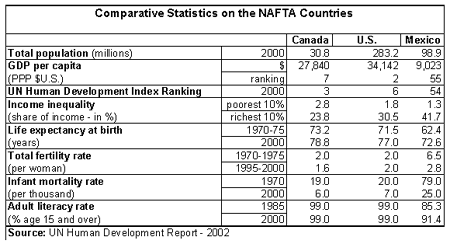
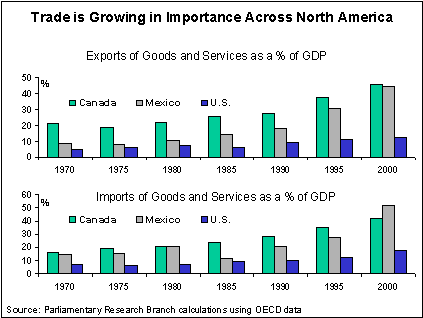
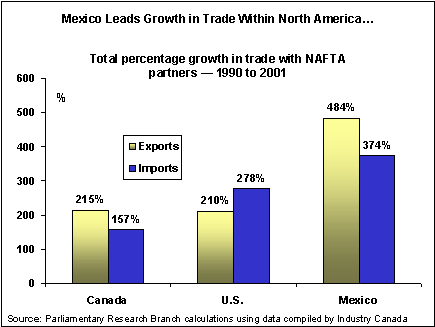
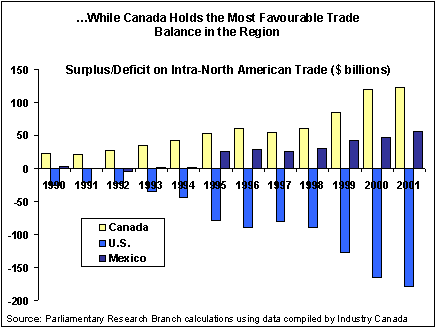
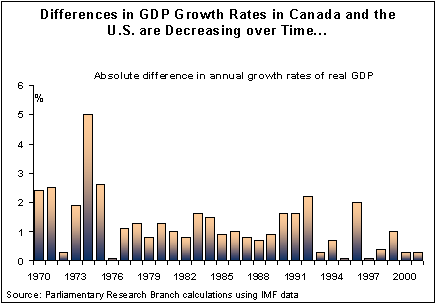
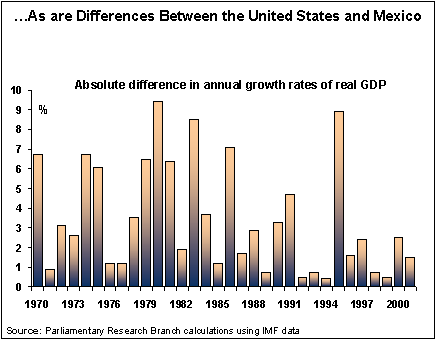
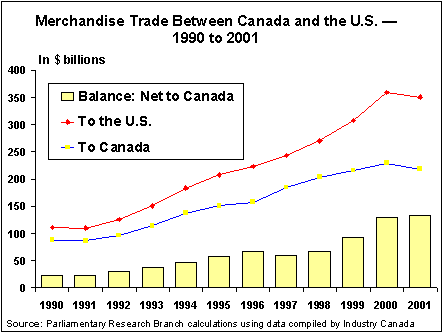
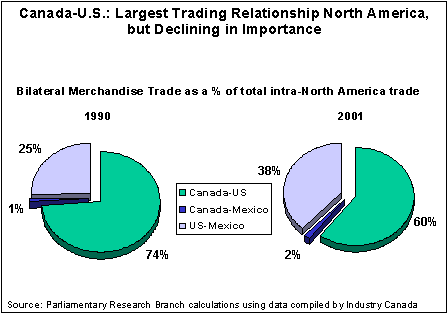
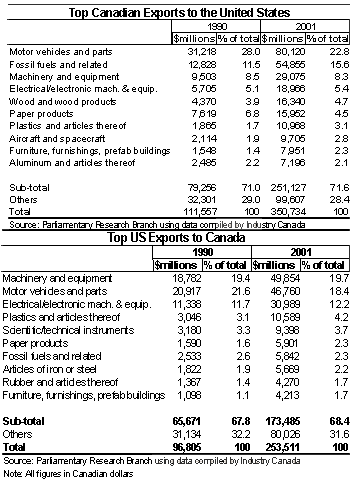 In the case of southbound trade, four broad categories of merchandise account for close to two-thirds of all Canadian exports to the United States. Motor vehicles and parts constitute Canada’s leading category of exports, accounting for 23% of the total in 2001. Crude oil, petroleum, natural gas, coal and other fossil fuels comprise the second-largest category of southbound trade. These non-renewable mineral products make up about 16% of shipments from Canada.
In the case of southbound trade, four broad categories of merchandise account for close to two-thirds of all Canadian exports to the United States. Motor vehicles and parts constitute Canada’s leading category of exports, accounting for 23% of the total in 2001. Crude oil, petroleum, natural gas, coal and other fossil fuels comprise the second-largest category of southbound trade. These non-renewable mineral products make up about 16% of shipments from Canada. 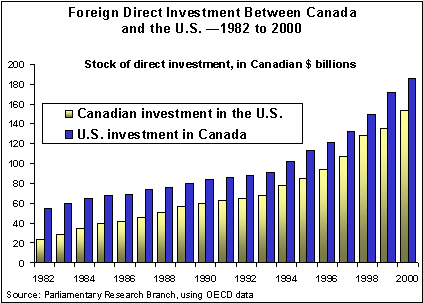
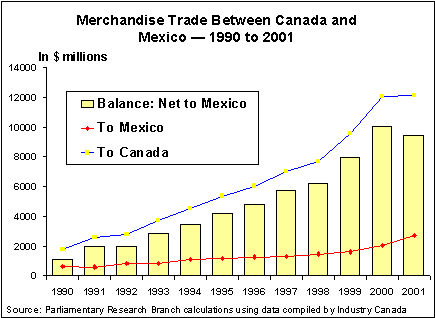
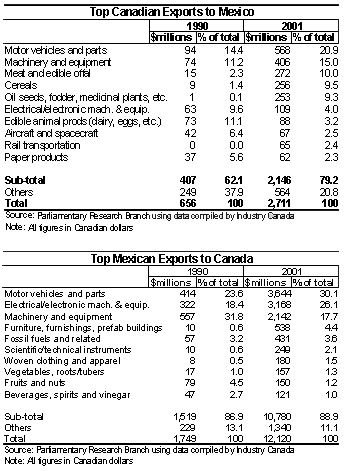 Canadian exports to Mexico are concentrated in a few major product groupings, but unlike Canada’s exports to the United States, shipments to Mexico represent a mix of manufactured goods and agricultural products. The largest grouping of export products, motor vehicles and parts, accounted for just over one-fifth of the total in 2001, followed closely by machinery and equipment, including electrical and electronic products.
Canadian exports to Mexico are concentrated in a few major product groupings, but unlike Canada’s exports to the United States, shipments to Mexico represent a mix of manufactured goods and agricultural products. The largest grouping of export products, motor vehicles and parts, accounted for just over one-fifth of the total in 2001, followed closely by machinery and equipment, including electrical and electronic products. 